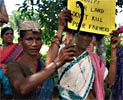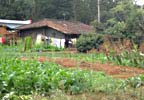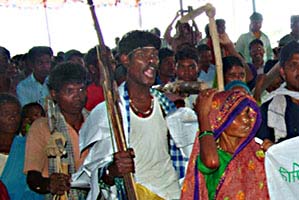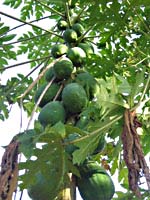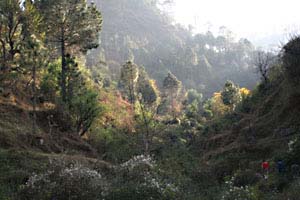Sponge Iron Industries - 1 - Resistance
See also: Sponge Iron Industries - part 2: pollution, displacement
or: overview photo series and articles resistanceThe last twenty years hundreds of iron factories came up in the centre of India, in the states Chhattisgarh, Jharkhand, Orissa and West Bengal. Life became a hell for the hundred thousands of villagers in its neigbourhoods, most tribal people. The air, the water, the land, everything became horribly polluted. It brought many diseases. Big trucks killed a lot of people in traffic accidents. Thousands and thousands Adivasis had to leave for the factories, and for the coal and iron mines. They became displaced persons.
The book Sponge Iron Industries [1] tells us the sad story of this new ‘development’. It also mentions the resistance of Adivasis fighting for their survival.
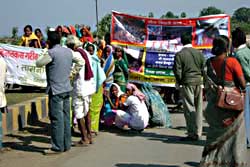 Every year people from Tamnar village commemorate police brutality.
Every year people from Tamnar village commemorate police brutality.
More pictures about police violence at Tamnar,
article and the yearly commemoration
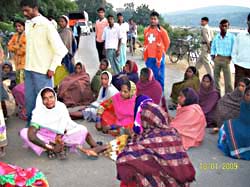 Framers from villages near the Rabo dam block the road, demanding jobs.
Framers from villages near the Rabo dam block the road, demanding jobs.
More pictures about resistance Rabo dam and article.
Resistance
(page 61) “(Since 2004) the consistent protests from several villages in Sundergarh district (in the East-Indian State Orissa) have forced almost seven plants to close down or withdraw. One such village, which refused to let a plant come up in its vicinity, is Kaikachar in Ratanpur panchayat. The experience of this village is unique and inspiring because a local youth group initiated the protest here. They call themselves Kiran Club. It started with two teenaged village girls, school drop outs, who started voluntary tuitions for younger kids in the village. Soon the group grew and started taking on more community activities.
In October 2004, this group (prepared) a street play for a youth festival in Bhubaneswar, the state capital. ‘ It was about mining and its negative impacts on villages and people.’
(..) Around the same time there was talk of Mahavir Hitech Ltd, a Kanpur-based company, buying land in the village to set up a sponge iron plant. People in the village had already heard of the experiences of other places in the district, but they were not sure what this plant would bring them in terms of benefits and problems. The Kiran Club members, with support from a local ngo, organised a trip to Kormunda, which was already facing a lot of problems due to pollution by these plants. They came back with not just stories, but also with samples of water, soil fruits, vegetables and clothes covered with dust.
A second trip was organised and this time more people, even those who were not members of the club, went. This was followed by spreading the message to other neighbouring villages in the panchayat (municipality) who would also be affected by the plant. The mobilisation of almost six villages turned into fierce opposition to the plant, and protests at several gram sabha (village) meetings. After a long struggle the Ratanpur panchayat managed to stop the factory from coming up.
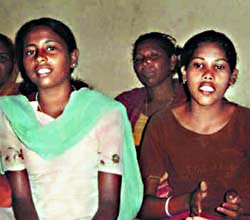 Two girls from Kaikachar village, Orissa, started an action group.
Two girls from Kaikachar village, Orissa, started an action group.
(page 54) In 2004, people jammed the Simga-Jabalpur national highway to oppose a sponge iron plant coming up in village Kathia (in Chhattisgarh). Villagers had formed the Ekta Sangharsh Samiti to protest the upcoming GPT Metal Industries of Kolkata.
(..) (Strong protests of) the villagers of Chauranga (in Chhattisgarh) managed to stall Raipur Sponge Iron Power Ltd’s 700 tonne plant. The company had bought agricultural land from individuals and had leased out a canal from the state and started building a plant without consulting the gram sabha (village meeting). It forged a consent letter from the gram sabha with the help of the sarpanch (village head). The village, which has a population of 25,000, put up a stiff resistance. For nine months people did not move from the factory site and would not allow any construction.
On August 15, 2004, barricades were put up to block anyone entering the village without permission. Committees were formed to meet the district collector, police and factory owner and convince them about the ill effects the proposed factory would have. But since the state administration had declared that the factory would start operating under police protection, the tussle turned violent and the police and administration resorted to beating protesters brutally and later arrested them.
On November 30, two youths, Narender and Rajkumar, tried to start work on the factory with the help of some outsiders. The situation took a very aggressive turn and the two youths were killed in the scuffle. As a result, 33 people from the village were convicted of the charge of murder.
While Chauranga has been a success story of sorts, the village is still under pressure, with 11 community members, 9
women and 2 men, in jail as a result of the unfortunate violent turn of events. The convicts have been sentenced life
imprisonment by the Sessions Court.”
Source
1. Infopack on Sponge Iron Industries - issues and campaigns; Manshi Asher, Rifat Mumtaz; National Centre for Advocacy Studies; Pune, Maharashtra, India, 2007.Go to next page: stiff resistance for many years
Go to: overview photo series and articles resistance
